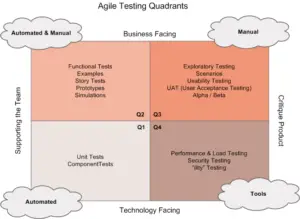What is Agile Testing?
Agile Testing is a type of software testing that follows the principle of agile software development. It is an iterative development methodology and the requirements evolve through collaboration between the customer and self-organizing teams.
An agile team works as a single team towards a common objective of achieving Quality. Agile Testing has shorter time frames that are known as iterations.
Using Agile Methodology in Testing
Static, cumbersome software is no longer an option for competitive companies; it’s critical to develop processes that quickly iterate new code and release new features while simultaneously ensuring high quality. As a result, many companies have turned to Agile development methodology, which focuses on fast iterations and constant evaluation to produce flexible, robust and stable software.
But understanding the value of Agile doesn’t guarantee easy adoption by the development team — adapting traditional QA processes to an Agile environment is not something you learn from a book, but a skill and culture developed through experience.
Best Practices For Continuous Testing in Agile
Critical to this process is the Agile testing life cycle. To ensure you’re producing the highest-quality software possible, testing cannot be confined to a standard approach at the end of the development cycle. Instead, it must be an ongoing effort that adapts to each unique Agile project.
- People: High-quality software starts with high-quality people working in an environment that supports their growth and adaptation to Agile. The “development team” in an Agile context has many engineers doing whatever tasks they are capable of doing, when and where needed, versus fixed roles.
- Process: Agile means being agile. Every organization needs to implement their own version of Agile depending on their software, structure and culture. The term, Agile Software Testing, needs careful thought in defining its breadth and depth throughout the process. In the beginning, it means well-thought out acceptance tests and user stories. While later, it means executing the software to see that the acceptance tests are passed.
- Product: A working product delivered in short iterations enables feedback and quick adaptation. This is the ultimate key to success.
- User: Users are king. Deliver and then listen to what they say. Focus on acceptance tests from the user point of view.
How to work with the agile methodology for testers
No methodology is perfect, and the agile approach comes with challenges on its own. There are however a few things a team can do to ensure success with the agile methodology.
- Encourage daily face-to-face communication between team members : This improves alignment, provides transparency regarding priorities, and ensures a common understanding of goals and deadlines. Scrum, is a commonly used framework for ensuring this kind of teamwork.
- Involve stakeholders across functions for the initial test phase : The first objective in terms of testing should be to create high level test scenarios for maximum impact on quality. This should be a joint effort between product owners, business development, programmers, and testers.
- Accept that change is the norm : Agile is a mentality of anticipating and accepting change. This also applies to testing, and it is important that team members are open to this way of working.
Life Cycle of Agile Testing

There are 5 different phases in the Agile Testing life cycle such as:
- Impact Assessment – In the first phase you have to gather inputs from stakeholders and users. Now this will be taken as feedback for the next deployment cycle.
- Agile Testing Planning – Here, the stakeholders come together to plan the schedule of the testing process, meeting frequency, and deliverables.
- Release Readiness – At this stage, you have to review the features that have been developed and check if they are ready to go live or not.
- Daily Scrums – This phase includes the everyday morning meetings to check on the status of testing and set the goals for the day.
- Test Agility Review – The final phase involves the weekly meetings with the stakeholders to review and assess the progress against milestones.
Agile Test Plan & Quadrants
The test plan is written and updated for every release for agile testing. It includes:
- The scope of the testing
- Consolidating new functionalities to be tested
- Types of testing/Levels of testing
- Performance & load testing
- Consideration of infrastructure
- Risks Plan
- Planning of resources
- Deliverables & Milestones
Quadrants
The agile testing quadrants separate the whole process in four Quadrants. So this helps you in understanding the process of agile testing.

Agile Quadrant I – This quadrant focuses on the internal code quality. It consists of test cases which are technology driven and are implemented to support the team. It includes:
- Unit Tests
- Component Tests
Agile Quadrant II – It contains test cases that are business driven and are implemented to support the team. This Quadrant focuses on the requirements. The kind of tests performed in this phase include:
- Testing of possible scenarios and workflows
- Testing of User experience
- Pair testing
Agile Quadrant III – This quadrant provides feedback to quadrants one and two. The test cases can be used as the basis to perform automation testing. Here, many rounds of iteration reviews are carried out which builds confidence in the product. The kind of testing done in this quadrant are:
- Usability Testing
- Exploratory Testing
- Pair testing with customers
- Collaborative testing
- User acceptance testing
Agile Quadrant IV – The fourth quadrant concentrates on the non-functional requirements such as performance, security, stability, etc. This quadrant helps the application to deliver the non-functional qualities and expected value. The tests performed are:
- Non-functional tests such as stress and performance testing
- Security testing with respect to authentication and hacking
- Infrastructure testing
- Data migration testing
- Scalability testing
- Load testing
